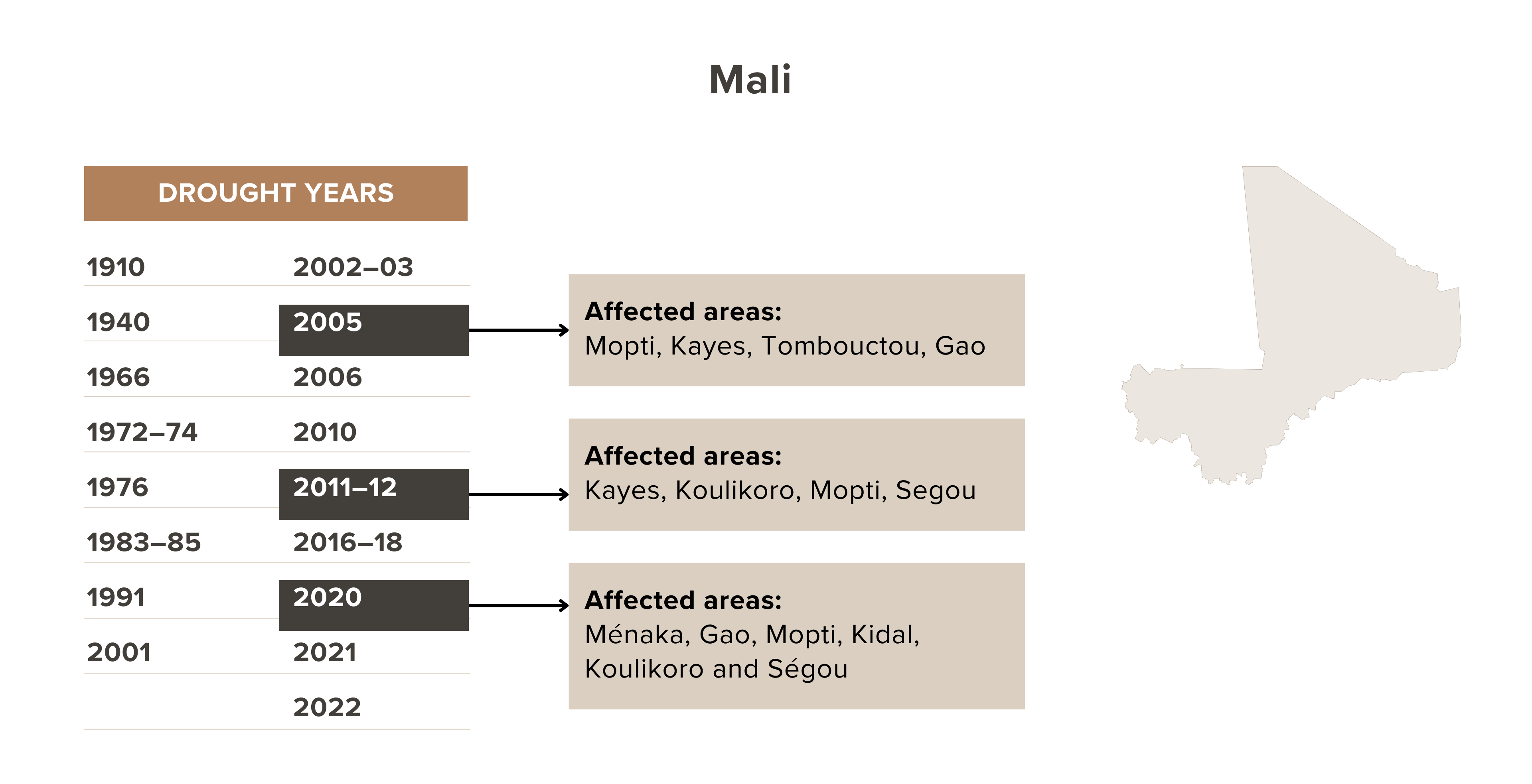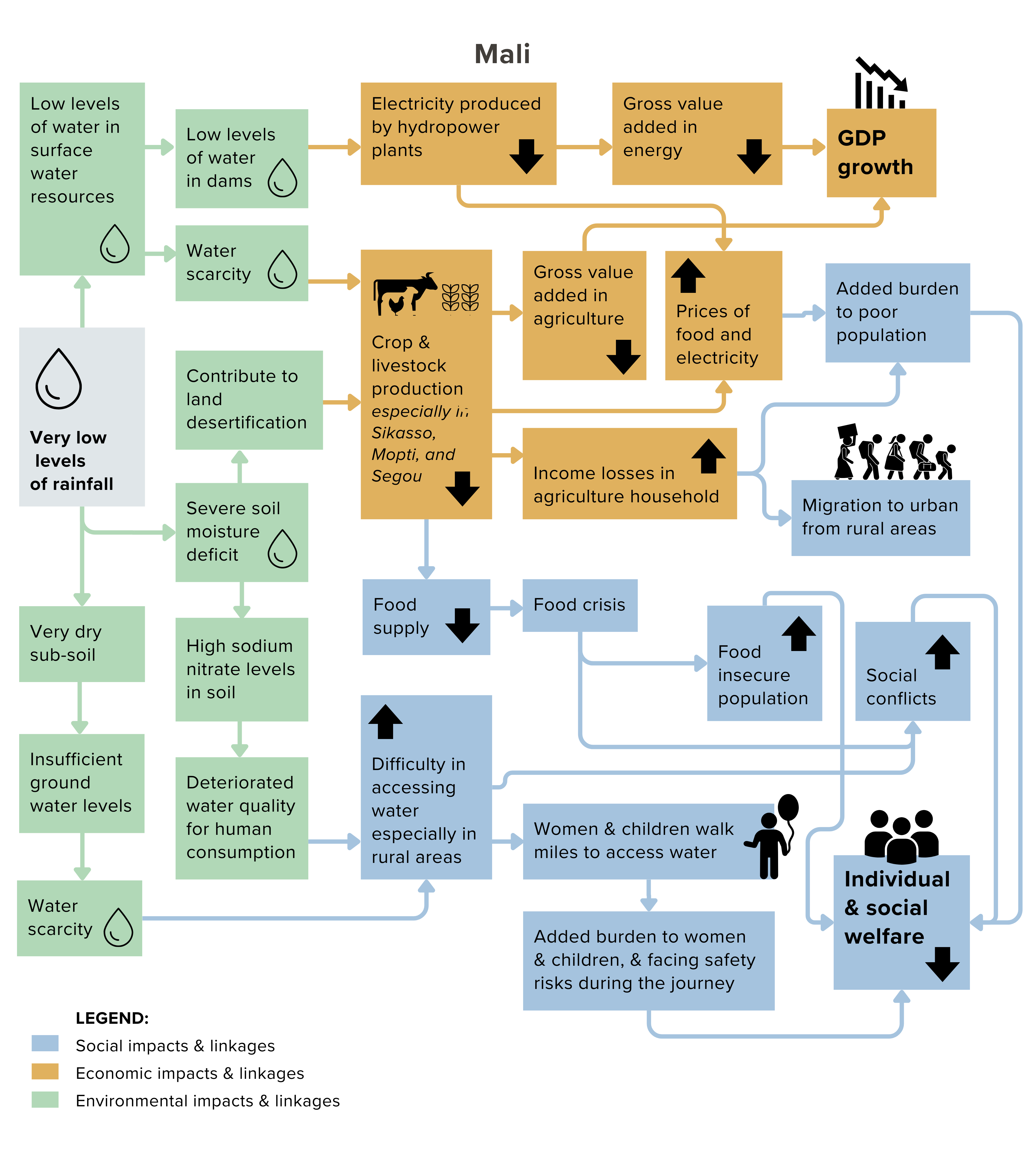
Mali
HISTORICAL DROUGHT – Mali is a landlocked country in West Africa, and among the nations that comprise the Sahel region. Drought is a recurring hazard in the country, as well as in the wider Sahel region. Mali experienced devastating droughts in the 1970s and 1980s, and the country continued to experience drought events from the 2000s until recent years.
Droughts in Mali are typically caused by long-term low levels of rainfall combined with periodic dry spells. There is a higher occurrence of drought in the northern part of the country, but the area is less populated than in the south. The north also typically receives little rainfall all year round. Recurrent droughts have influenced the changes in the composition and characteristics of vegetation in Mali. In recent years, rainfall has been too scarce to replenish the water tables in the country, especially in overexploited areas.

DROUGHT IMPACT PATHWAY – Because of the extreme lack of rainfall and the effects of high temperatures on soil characteristics, droughts had high negative impacts on agriculture, energy, and water utility sectors in Mali. Severe and prolonged drought events also had dangerous impacts on the welfare of the population in terms of food security, and availability of water for drinking and sanitation, especially in the rural areas. Such conditions also led to social conflicts among the affected people. Women and children are heavily impacted as they travel long distances to access water, facing security and safety risks along the journey.

Highlights of drought vulnerability dimensions
- 22.6 million population, with 54.6% living in rural areas (2022).
- 44.6%, national poverty rate.
- Menaka, Sikasso, Ségou, and Mopti registered the highest poverty rates, living below USD 3.65 and USD 6.85 (2017 PPP) (2023).
- 22.1% female literacy rate (aged 15+) compared to 40.4% male literacy rate (2020)
- Women and girls aged 15+ spend 20.4% of their time on unpaid care and domestic work, compared to 2.5% spent by men (2018)
- Proportion of women who were married or in a union before age 18 (53.7%); before age 15 (15.9%)
- 18.4% of women aged 15-49 years reported that they had been subject to physical and/or sexual violence by a current or former intimate partner in the previous 12 months (2018).
- Main minority groups: Peuhl, Songhai, Tuareg, Maure, Soninké, Senoufo, Minianka. Dogon, Bozo, Diawara, Xaasongaxango.
- Agriculture comprises 36.4% of GDP and 68.0% of total employment (2022).
- The livestock industry is an important component of the agricultural economy.
- A vast majority of farmers are small shareholders.
- The Inner Niger Delta (IND) has 1.5 million people and accounts for 80% of national fish harvests, 15% of cereal cultivation, and sustains 50% of Mali’s livestock in the dry season.
- 80% of the population living around the IND rely on waterways for transportation and shipping.
- Hydropower contributes more than half of the total electricity generation in the country.
- 65.0% of employed women are in agriculture, compared to 69.9% of employed men (2022).
- 51.6% female labor force participation rate, compared to 82.1% male labor force participation rate.
- Songhai people are mostly settled subsistence farmers, while Maure people live in northern Mali, & are traditionally herders of goats and sheep.
- As of 2017, 9 hydropower plants in Mali which are operational or under construction.
- The installed hydropower capacity in Mali is 220MW (2022).
- The country has several dams, such as Manantali (11,270 MCM capacity, used for irrigation, hydroelectricity), Sélingué (2,170 MCM capacity, used for irrigation, flood control, hydroelectricity), Markala (175 MCM capacity, used for irrigation).
- It has 8 operational wastewater treatment stations that provide limited treatment for select facilities, such as hospitals, airports, government buildings, and inflows from the mini sewerage systems.
- 50.2% of the total population & 41.9% of rural population using at least basic sanitation services.
- 83.6% of the total population & 74.4% of the rural population use at least basic drinking water services.
- Irrigation constitutes 99% of all water withdrawals. Flood irrigation for paddy rice fields is the most common irrigation technique.
- Small-scale groundwater extractions are used in various activities in rural communities (e.g. drinking water, small-scale irrigation, and livestock).
- Mali has 3 agroecological zones: the Desert (41%), Sahelian, and Sudanese.
- There is wide disparity in water availability in various areas in Mali due to the spatial variations in climate from southwest to northeast.
- Annual precipitation in the Desert or arid zone is less than 400 mm; in the Sahelian or semi-arid zone, between 400 and 800 mm; in the Sudanian or semi-humid zone, more than 800 mm.
- Water stress is experienced in areas away from the rivers (rural areas).
- Mali has 3 main river basins: Niger (47%), Senegal (11%) and Volta (1%).
- Inner Niger Delta (IND) in Central Mali is one of the most important inland deltas in the world, with rich wetlands that support wildlife, fisheries, livestock and floating rice.
- Limited arable lands in Mali found along the Niger River in the Kayes, Koulikoro, Segou, Mopti and Sikasso regions.
- Groundwater is the primary source for drinking water and domestic use.
- 87% of the rural population, 30% of the urban population, and 55% of Bamako's population depend on groundwater; high pathogenic contamination in Bamako’s groundwater.
- In recent years, rainfall has been too scarce to replenish the water table in Mali, especially in overexploited areas.
- In urban areas, poor sanitation systems and chemical contamination from gold mines, slaughterhouses, dyeing industries, and tanneries threaten surface water quality.
- Mali developed the Mali National Drought Plan 2021-2025 to improve drought risk management.
- Plans related to drought risk management, disaster risk reduction, climate change: National Action Plan for Integrated Water Resources Management (2009, revised in 2019), Strategy and Action Plan for the Implementation of Mali’s Great Green Wall (2012), National Disaster Risk Reduction Strategy, Strategic Framework for Economy Development and Sustainable Development (2019-2023).
- Government agencies relevant to drought risk management: Ministry of Energy and Water, National Hydraulics Directorate, National Water Council, National Directorate of Water and Forests, Agency for the Environment and Sustainable Development, Great Green Wall Agency, Food Security Commission.
- Institutional laws and regulations related to water, drought risk management, disaster risk reduction, climate change: National Water Code (2002), National Water Policy (2006), National Policy for the Protection of the Environment (2009), National Policy on Climate Change (2011), National Agricultural Land Policy (2014), Decree No. 2016-0346 / P-RM (National Strategy on Disaster Risk Reduction), Law on Agricultural Land Tenure (2017).
- Mali has a Disaster Response Implementation Framework.
- Early Warning System in place.
- Land Degradation Neutrality Technical Committee responsible for implementing framework of Land Degradation Neutrality.
Centre for Research on the Epidemiology of Disasters. 2024. In: Emergency Events Database EM-DAT. [Cited 2 April 2024]. https://www.emdat.be/
International Committee of the Red Cross. 2022. Climate Change in Mali: “We drilled deep but found nothing”. In: International Committee of the Red Cross. [Cited 15 April 2024]. https://www.icrc.org/en/document/climate-change-mali-we-drilled-deep-found-nothing
Minority Rights Group. 2023. Mali. In: Minority Rights Group. [Cited 17 April 2024]. https://minorityrights.org/country/mali/
Republic of Mali. 2020. Plan National Secheresse Du Mali 2021-2025. [Cited 15 April 2024]. https://www.unccd.int/country-profile-document/mali
UN Women. 2024. Mali. In: UN Women. New York, USA, UN. [Cited 15 April 2024]. https://data.unwomen.org/country/mali
United States Agency for International Development. 2021. Mali Water Resources Profile. [Cited 17 April 2024]. https://www.globalwaters.org/resources/assets/mali-water-resources-profile
World Bank. 2019. Disaster Risk Profile: Mali. Washington, DC, World Bank.
World Bank. 2023. In: Subnational Poverty and Inequality Database (SPID). [Cited 9 April 2024]. https://datacatalog.worldbank.org/search/dataset/0064796/subnational_poverty_and_inequality_database_spid
World Bank. 2023. Mali Economic Update, Special Chapter: Strengthening Financial Resilience of Pastoralists to Drought. Washington, D.C., World Bank.
World Bank. 2024. In: World Bank Open Data. [Cited 9 April 2024]. https://data.worldbank.org/
FOCUS on Vulnerability
Economic sectors:
agriculture, energy, water utility.
Social groups:
rural populations, women population, rural women, children, agriculture households, people employed in agriculture, poor population, minority groups, especially Songhai & Maure people.
Geographical areas:
agriculture areas, rural areas, Inner Niger Delta, Menaka, Sikasso, Ségou, Mopti, Kayes, Koulikoro, Bamako.
